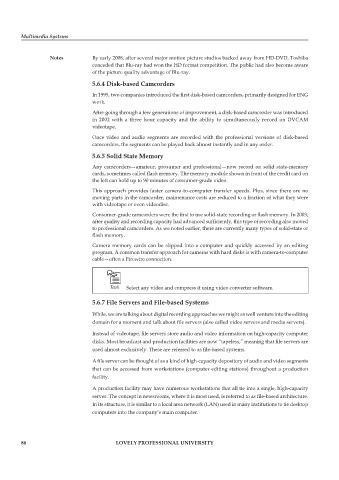Page 92 - DCAP303_MULTIMEDIA_SYSTEMS
P. 92
Multimedia Systems
notes By early 2008, after several major motion picture studios backed away from HD-DVD, Toshiba
conceded that Blu-ray had won the HD format competition. The public had also become aware
of the picture quality advantage of Blu-ray.
5.6.4 Disk-based Camcorders
In 1995, two companies introduced the first disk-based camcorders, primarily designed for ENG
work.
After going through a few generations of improvement, a disk-based camcorder was introduced
in 2002 with a three hour capacity and the ability to simultaneously record on DVCAM
videotape.
Once video and audio segments are recorded with the professional versions of disk-based
camcorders, the segments can be played back almost instantly and in any order.
5.6.5 solid state Memory
Any camcorders—amateur, prosumer and professional—now record on solid state-memory
cards, sometimes called flash memory. The memory module shown in front of the credit card on
the left can hold up to 90 minutes of consumer-grade video.
This approach provides faster camera-to-computer transfer speeds. Plus, since there are no
moving parts in the camcorder, maintenance costs are reduced to a fraction of what they were
with videotape or even videodisc.
Consumer-grade camcorders were the first to use solid-state recording or flash memory. In 2003,
after quality and recording capacity had advanced sufficiently, this type of recording also moved
to professional camcorders. As we noted earlier, there are currently many types of solid-state or
flash memory.
Camera memory cards can be slipped into a computer and quickly accessed by an editing
program. A common transfer approach for cameras with hard disks is with camera-to-computer
cable—often a Firewire connection.
Select any video and compress it using video converter software.
5.6.7 file servers and file-based systems
While, we are talking about digital recording approaches we might as well venture into the editing
domain for a moment and talk about file servers (also called video servers and media servers).
Instead of videotape, file servers store audio and video information on high-capacity computer
disks. Most broadcast and production facilities are now “tapeless,” meaning that file servers are
used almost exclusively. These are referred to as file-based systems.
A file server can be thought of as a kind of high-capacity depository of audio and video segments
that can be accessed from workstations (computer editing stations) throughout a production
facility.
A production facility may have numerous workstations that all tie into a single, high-capacity
server. The concept in newsrooms, where it is most used, is referred to as file-based architecture.
In its structure, it is similar to a local area network (LAN) used in many institutions to tie desktop
computers into the company’s main computer.
86 LoveLy professionaL University

